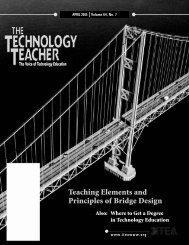K-12 Engineering Education Standards: - International Technology ...
K-12 Engineering Education Standards: - International Technology ...
K-12 Engineering Education Standards: - International Technology ...
You also want an ePaper? Increase the reach of your titles
YUMPU automatically turns print PDFs into web optimized ePapers that Google loves.
ΣFy = 0<br />
-F MT<br />
sin θ –F NT<br />
– F OT<br />
sin θ = 0<br />
-(-18.77)(.916) – 0 –F OT<br />
(.916) = 0<br />
-17.19/-.916 = F OT<br />
18.77 N = F OT<br />
(T)<br />
ΣF X<br />
= 0<br />
-F MT<br />
cos θ + F OT<br />
cos θ + F TU<br />
= 0<br />
-(-18.77)(.41) + 18.77(.41) + F TU<br />
= 0<br />
-7.67 -7.67 = F TU<br />
-15.35 N = F TU<br />
(C)<br />
Step 8.<br />
Draw a free body diagram (Figure 8) around Joint O.<br />
Figure 8.<br />
ΣF y<br />
= 0<br />
-F NO<br />
– F OT<br />
cos θ + F OP<br />
= 0<br />
-(7.68) – 18.77(.41) + F OP<br />
= 0<br />
F OP<br />
= -7.68 -7.68<br />
F OP<br />
= -15.35 N (T)<br />
ΣFX = 0<br />
F OT<br />
sin θ + F OU<br />
= 0<br />
18.77(.916) + F OU<br />
= 0<br />
F OU<br />
= -17.2 N (C)<br />
Step 9.<br />
Draw a free body diagram (Figure 9) around Joint U.<br />
Figure 9. Joint U.<br />
ΣF y<br />
= 0<br />
-11.45 –F OU<br />
– F PU<br />
sin θ = 0<br />
-11.45 – (-17.2) – F PU<br />
(.916) = 0<br />
F PU<br />
= -5.75/-.916 = 6.28 (T)<br />
ΣF X<br />
= 0<br />
-F TU<br />
+ F PU<br />
cos θ + F UV<br />
= 0<br />
-(-15.34) + 6.28(.41) + F UV<br />
= 0<br />
F UV<br />
= -17.9 N (C)<br />
Since the bridge is symmetrical, the other side of the bridge<br />
has the same forces acting upon its members. Below is a<br />
table that reflects which members are equal on both sides of<br />
the bridge. If the bridge is not symmetrical, the remaining<br />
joints on the other side of the bridge will need free body<br />
diagrams and equations of equilibrium to determine the<br />
remaining members.<br />
MT, SX = 18.77 N (C)<br />
NO, QR = 7.68 N (T)<br />
UV, VW = 17.9 N (C)<br />
MN, RS = 7.68 N (T)<br />
TU, WX = 15.35 N (C)<br />
PV = 11.45 N (C )<br />
NT, RX = 0<br />
OU, WQ = 17.2 N (C)<br />
OP, PQ = 15.35 (T)<br />
OT, QX = 18.77 N (T)<br />
PU, PW = 6.28 N (T)<br />
Figure 10. Bridge with Compression and Tension<br />
Summary<br />
Bridges can be a very good tool for reinforcing<br />
mathematical concepts with engineering and technology<br />
students. The equations above are a template for any<br />
teacher to use with his or her students when teaching<br />
students about bridge building. This template can lead to<br />
in-depth discussions about compression and tension and<br />
give students an understanding of how bridges actually<br />
work. Building and crushing bridges is fun for students,<br />
but this activity can also be a means for them to implement<br />
math and science skills through predictive analysis.<br />
33 • <strong>Technology</strong> and <strong>Engineering</strong> Teacher • February 2011
















